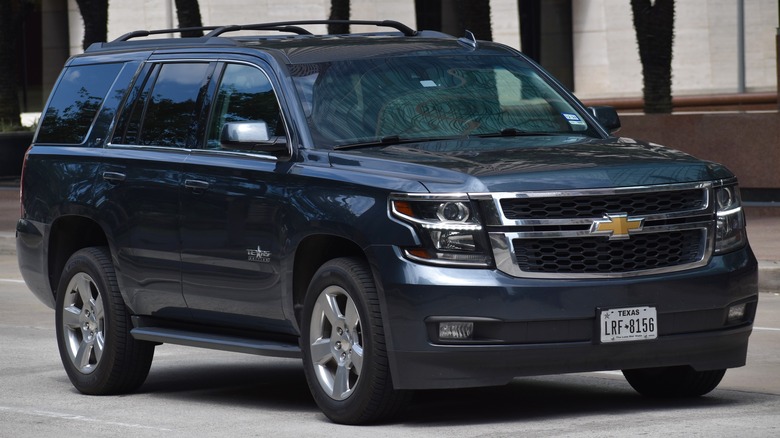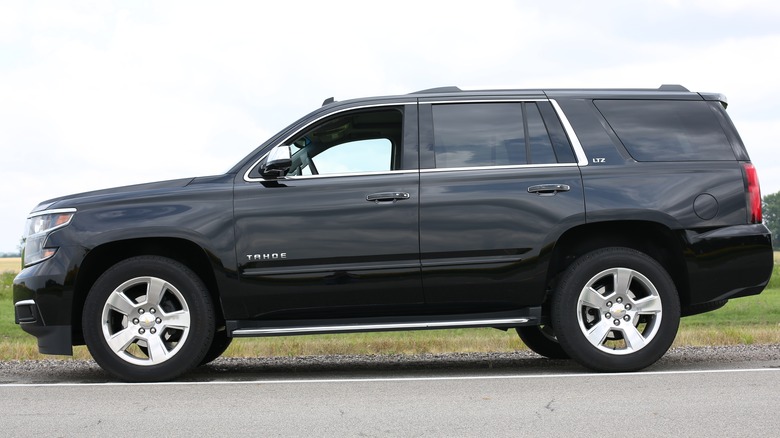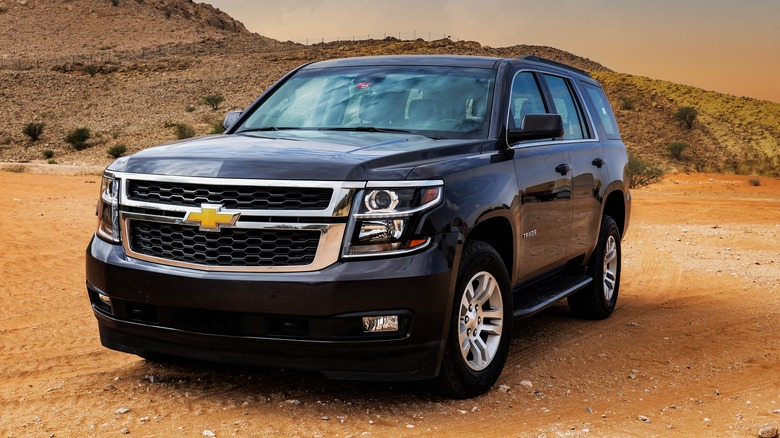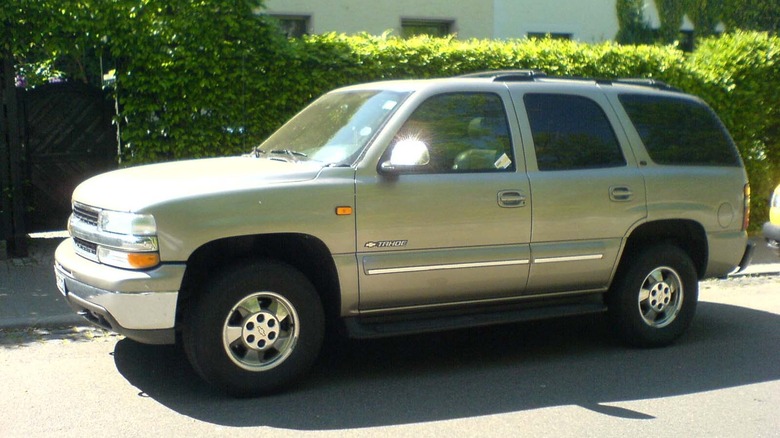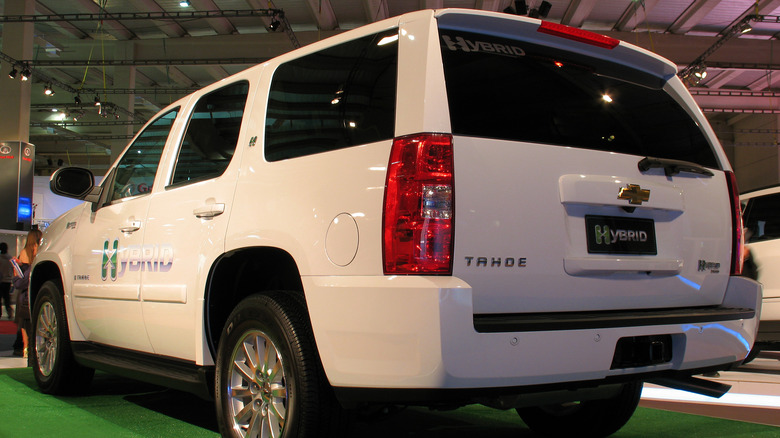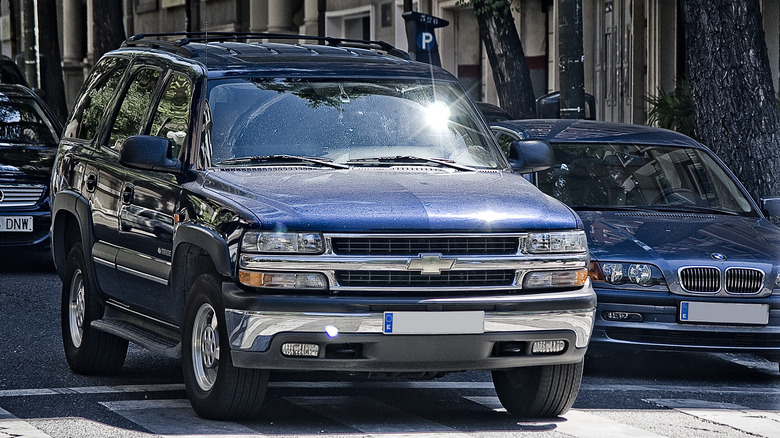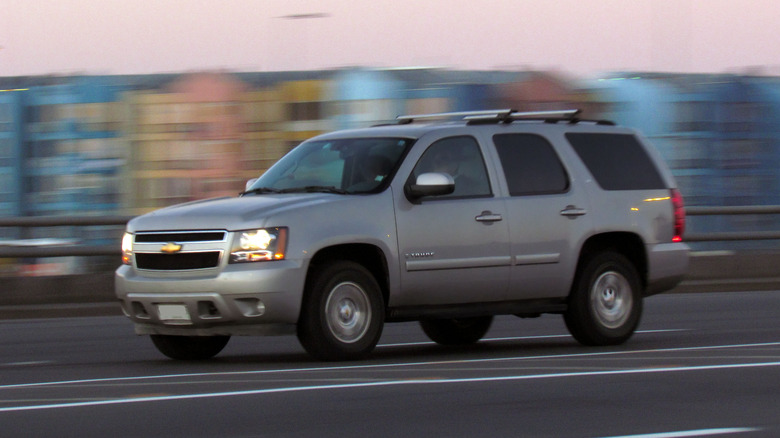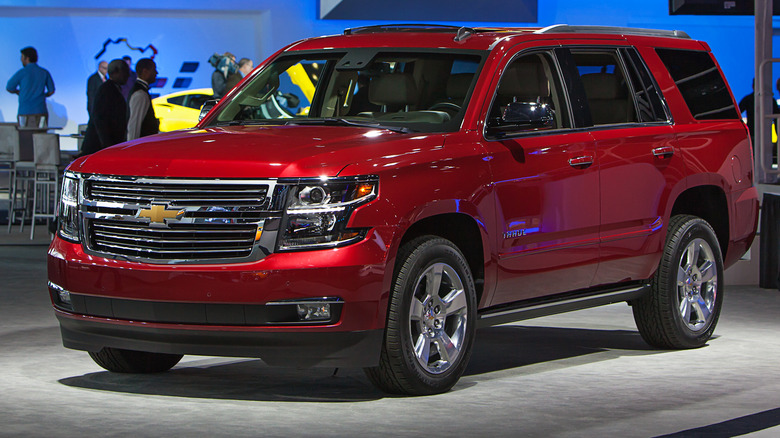The Best Years For Chevy Tahoe (And Some To Avoid)
The Chevrolet Tahoe has been a mainstay of the SUV market for many years. It is a robust and reliable four-wheel-drive vehicle built on a truck chassis that gives it a leg up in the off-road capability market. In short, the Tahoe has been one of the most powerful SUVs from a major brand since the 1991 model year.
Birthed from the legacy of the cool and unique features of the K5 Blazer, Chevrolet envisioned the truck as offering something more. The K5 was rough and ready, and the Tahoe needed to be the same, but with a nod toward driver comfort and luxury. But not all Tahoes are created equal. The nameplate has been around for over thirty years and seven generations. Despite constant improvement and development, some generations don't live up to the hopes and expectations of their fanbase.
One of the best SUVs on the market, the Chevrolet Suburban, inspired the original Tahoe. American families realized that the SUV format could perform just as well as a minivan or station wagon while allowing drivers to tow a boat, a camper, or plow a snowy street.
The Tahoe nameplate has endured since 1991, and the used market is filled with options for the discerning buyer. However, not every Tahoe purchase is a slam dunk. As an amateur gear monkey and passionate four-by-four enthusiast, I've been enjoying four-wheel drive off-road vehicles for decades. Coupling that experience with research into the used market, consumer reports, NHTSA and IIHS statistics, and government recall data, we've determined which years of Tahoe production are best for used car buyers and which should be avoided at all costs. Let's take a look.
Best: 2014
By the end of the third generation, Chevrolet had a good handle on what made the Tahoe work. The last model year of the third-generation Tahoe hits a sweet spot of modern features, fuel efficiency, and towing capacity. It claims the highest towing capacity for any Tahoe, capable of pulling 8,500 pounds, more than enough for casual needs, thanks to a 5.3 liter V8 producing 320 horsepower and 335 lb-ft of torque running through a six-speed transmission that drivers praise.
Modern technology helps boost fuel efficiency thanks to a system that shuts down cylinders when unnecessary. Though the EPA estimated 15 mpg city and 21 mpg highway won't raise any eyebrows in today's world of EVs, it is a respectable number for a nearly 10-year-old car.
JD Power rates the 2014 Tahoe an overall 81 out of 100, with the best quality, reliability, and resale value scores. Today, the average cost of a used Tahoe is $21,142, which is not bad considering the original MSRP hovered in the $50,000 range.
The 2014 Tahoe also gets a nod for an improved interior, with wood grain and leather materials marking a significant upgrade from previous models. The Tahoe is spacious, with third-row seating that allows up to nine passengers. However, to take advantage of the total 108 cubic feet of cargo space, the rear row must be removed and the second folded down — a disadvantage compared to competitors like the Ford Expedition, which has foldable third-row seating.
Best: 2019
Up to date with the bells and whistles of modern cars without the cost of a brand-new vehicle, the 2019 Tahoe hits the sweet spot of fuel efficiency, comfort, and gadgets. Built on the same platform as Chevy's full-sized Silverado pickup, the 2019 Tahoe has the tools to go off the beaten path thanks to high ground clearance and optional four-wheel drive.
The 2019 Tahoe puts the utility in sport utility, with drivers reporting that it leaves a tad to be desired in the comfort area. Like its K5 antecedent, the Tahoe resembles a truck with a roof and extra rows of seats. However, with a base MSRP of $48,000, Chevy isn't exactly pricing it as a luxury build, and that cost climbs quickly. The fully loaded version hit the market with a $62,000 price tag, with the 6.2-liter V8 option tacking on an additional $6,000.
Still, even without the premier package, there are plenty of nods to comfort and convenience in the 2019 Tahoe. Apple CarPlay, large touch screens, remote start, and zone climate control are all included in the base package. The base 5.3-liter V8 is adequate, making 355 horsepower through a six-speed automatic transmission, while the premium 6.2-liter V8 makes 420 hp and gets upgraded to a 10-speed automatic transmission.
Best: 2001
Buying the generation of a model is not always a good idea, as manufacturers take time to ensure all the systems work together nicely and remain durable. The 2001 Tahoe is a couple of years into the generation, resulting in a smooth and stable ride. Engineers lowered the door sills for easier ingress across all four of the available models. The 6.2-liter option had yet to arrive on the scene in 2001, but the 5.3-liter V8 drives the four-wheel drive options, with a smaller 4.8-liter for the two-wheel drive Tahoes.
The 2001 Tahoe came in four models: base, LS, LT, and the off-road Z71 package. Much like the 2024 Z71 package, the 2001 version had a stiffer suspension, which paid off when off-roading, and included skid plates, a locking rear differential, and a roof rack. The rear doors also offered buyers cargo doors or a traditional tailgate. The conventional hatch included a power rear window that could be wound down via the remote, which is convenient for loading up groceries or accessing the rear with a trailer attached.
Though the popular third row is present, it is less comfortable than the two primary rows of seats, and drivers must remove it to fully utilize the cargo space. Consumer Reports awarded it a 5 out of 5 for reliability. One of the most reliable years of the Tahoe, it's not uncommon to see vehicles with over 200,000 miles on the clock. The 2001 Tahoe is riding in the sweet spot of being old enough not to be particularly desirable while still offering a ton of value with an average used price of $18,619.
[Featured image by Matti Blume via Wikimedia Commons | Cropped and scaled | CC BY-SA 2.0]
Best: 2009
Three engine choices and the first six-speed transmission give the 2009 Tahoe a wide range of capabilities. The 2009 Tahoe has four drivetrain options, including a 295 hp V8 in the base LS trim, which also has the option of a 320 hp V8. The premium LTZ trim includes a 395 horsepower option and a hybrid option with 332 horsepower. The 2009 model is also the first to offer the six-speed transmission, giving drivers an extra gear that comes in handy cruising on the highway or towing.
The Tahoe can accommodate up to nine passengers, including the third-row seating, though in true GM fashion, the interior leaves a bit to be desired. Though roomy and comfortable, reports of dashboard cracking and cheap plastic pieces detract from the experience.
With an average used sale price of shy of $20,000, the 2009 Tahoe represents an excellent value in the used car market.
[Featured image by RLGNZLZ via Wikimedia Commons | Cropped and scaled | CC BY-SA 2.0]
Avoid: 2004
The 2004 Tahoe's main problem can lead to costly repairs. An inordinate number of drivers report that after about 80,000 miles, the Tahoe starts drinking coolant like gasoline. Mechanics traced the problem back to cracked heads that require replacement. Tearing the top end off an engine is no small task. While the cracked heads are not a safety issue, as is the case with many of the problems endured by the 2015 model, all that coolant can cost a lot of a money over time. But the problem is expensive to fix, too.
On average, a replacement head costs over $3,000 to repair. Additionally, bad head gaskets are a problem that often arises at around the 64,000-mile mark, and cost an additional $2,000 to repair on average. And while the speedometer is not critical to the operation of the vehicle, consumers have reported that it becomes inaccurate at around the same time as the head gasket goes too — another hit to the wallet that potential buyers would do well to avoid.
[Featured image by Spanish Coches via Wikimedia Commons | Cropped and scaled | CC BY-SA 2.0]
Avoid: 2007
The 2007 Tahoe has the most reported problems of any Tahoe. Though not so serious or systemic as to demand recalls, it's extremely common for the dashboard to crack along its length. Overall, the 2007 model is infamous for interior and accessory problems, but one major costly repair should torpedo any thoughts of getting behind the wheel of a 2007 model.
At about 100,000 miles, low oil pressure warnings bring many Tahoe owners into the shop for a repair. Unfortunately for them, it is no simple repair. The 2007 is particularly notorious for requiring a complete engine swap to fix the problem, which is neither convenient nor good for the wallet. Combined with ticky-tack issues like broken accessories and an interior that falls apart, avoiding the 2007 model is a good move for prospective buyers.
The 2008 model also shares many of the faults of the 2007, though not as severe, so keeping away from that year is also advisable.
[Featured image by order_242 via Wikimedia Commons | Cropped and scaled | CC BY-SA 2.0]
Avoid: 2015
In over 30 years of Tahoe production, the 2015 model suffers from the most faults. It holds the record for the most recalls required by any Tahoe model. Problems include but are not limited to seat belt tensioners, stability control systems, anti-lock brakes and traction control, power steering systems, airbags, ignition systems, transfer cases, tie rods, and power trains.
Of course, Chevrolet fixes these issues when a diligent owner brings it in, but there is no guarantee that those who owned it before you did their due diligence. Best to avoid 2015 altogether or check your VIN against recall numbers to ensure every problem has been addressed. The NHTSA has issued a total of 16 recalls for the 2015 Tahoe.
Consumer Reports gives the 2015 Tahoe about a 50 out of 100 for reliability. Many of the above-mentioned problems also apply to similar cars from the same brand umbrella, such as the Silverado, Yukon, Sierra, and Suburban, so avoiding that year's GM SUV may be wise.
Methodology
Evaluating a vehicle sight unseen can be a tricky business. Not only is every used car a reflection of its prior treatment and maintenance, some of which is impossible to determine, but every buyer's needs are different. At SlashGear, we take a holistic approach to evaluating which years, models, or vehicles are worth (or distinctly not worth) your time. Market research publications, federal safety data, consumer reporting, recalls, manufacturing data, used values, and our own personal experience all contribute to our determinations.
